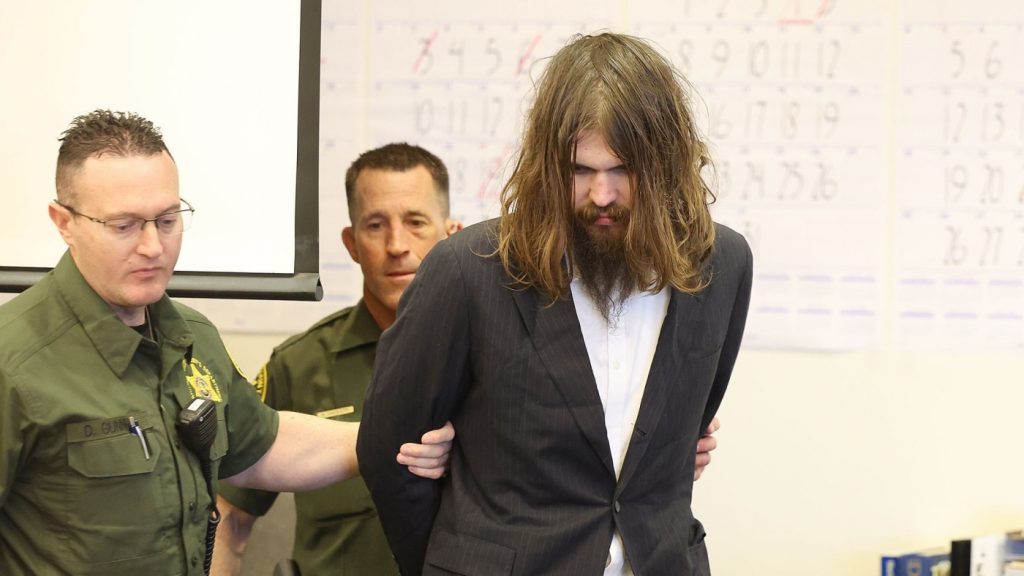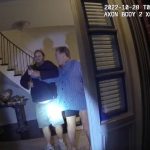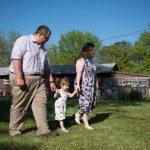It was six days into the massive, nationally-watched search for a missing 19-year-old last seen at a small Lake Forest park, and something just wasn’t making sense to the lead homicide investigator who had been assigned to assist the Orange County Sheriff Department’s missing person team.
Cell phone records outlining the movement of Blaze Bernstein — the missing young man — and Samuel Woodward — the former classmate who authorities for days had already suspected of being involved in the disappearance — were showing both their phones in the same area of Borrego Park during the early morning hours, at which point the signal for Bernstein’s phone signal abruptly disappeared but Woodward’s continued to move.
Dozens of search and rescuers, volunteers, family members and deputies had spent more than a week going over the park, including the area where Bernstein’s cell phone signal appeared to cease. But Sgt. Dylan Jantzen and several other members of the homicide team decided to head out to check the area again.
The warmer weather that aided the early days of the search was gone, replaced by the time the investigators began scouring the bushes on the outskirts of the park with a winter chill and pouring rain. As Jantzen peered into a pipe in an unlocked drainage area he heard a colleague urgently cry out his name.
“Just the way he said it, I knew,” Jantzen recalled during recent courtroom testimony. “I turned around and walked over to him and I saw what I saw.”
Hours of heavy downpour had unveiled portions of Bernstein’s body in a makeshift grave among the bushes. A tragic end to a missing persons case that drew interest around the country immediately turned into a full-scale homicide investigation which, more than five years later, has led to the ongoing murder trial of Woodward.
Testimony from investigators — which has made up much of the prosecution case — has provided the most detailed picture yet as to how a frantic search for the missing Woodward turned into the highest profile Orange County murder case in recent memory.
Bernstein, a pre-med student at the University of Pennsylvania who was visiting his parent’s home for winter break — left the family residence late on Jan. 2, 2018 and never returned. Through Bernstein’s social media accounts, his parents learned he had met up with Woodward, a former classmate at the Orange County School of the Arts.
In phone calls with the parents and a deputy taking a missing persons report, Woodward said he drove Bernstein to the park, where he claimed Bernstein got out of his parked car to go meet a third person whose identity Woodward didn’t know. Woodward at one point described standing by bathrooms next to the parking lot and watching as Bernstein walked to a trail or pathway on the other end of the park.
The parents of Blaze Bernstein, Jeanne Pepper and Gideon Bernstein, embrace prior to reading a family statement at a press conference at the Orange County Sheriff’s Department in Lake Forest on Wednesday, Jan. 10, 2018 to announce that a body discovered in Borrego Park has been identified as their missing son Blaze Bernstein . (Photo by Leonard Ortiz, Orange County Register/SCNG)
Bernstein’s parents — who lived near Borrego Park and knew it well – didn’t believe that what Woodward was telling them made any sense. Law enforcement would soon have their own suspicions.
Members of the sheriff’s department search and rescue team gathered in the parking of a Hobby Lobby near the park. Joseph Saddler, a former reserve deputy and veteran of hundreds of searches, described teams spreading out inside the park and within the nearby — and far larger — Whiting Ranch trail system.
The search teams went over trails, looked through drainage areas, and did line searches in heavy vegetation. ATV riders assisted with the trail searches, while helicopters and drones kept an eye out overhead. As the search dragged on for days, the hope for finding Bernstein alive waned.
“On (January 4) I was told I was searching for a missing person, by (January 6) I came to the conclusion that I may be searching for someone who is deceased,” Saddler said.
From the beginning, it didn’t seem like a normal missing person case, Capt. Jack Ackerman said.
“It seemed like it would be unusual for someone to go missing at night in the dark and cold with no resources,” the captain testified.
Investigators were juggling a flood of tips from the general public and social media, including hundreds of tips submitted to a public phone line.
“We were getting inundated by the public, by businesses, by social media tips,” Jantzen said. “We were getting information from Blaze’s friends, people who didn’t even live in the state of California, from the Bernstein family, from the family attorney. It was a lot.”
A memorial to Blaze Bernstein at the rear of Borrego Park in Foothill Ranch on Wednesday, May 15, 2024. Samuel Woodward is accused of stabbing former high school classmate Blaze Bernstein to death in Jan. 2018 and burying the body at the edge of Borrego Park in the Foothill Ranch area of Lake Forest. (Photo by Mark Rightmire, Orange County Register/SCNG)
Related Articles
Bay Area man’s arrest reveals secret California to Hawaii meth ring, alleged motive for social worker’s targeted killing
Man was killed Jan. 31 in East Bay shooting that was previously undisclosed to the public
Bay Area man arrested on suspicion of killing his 78-year-old mother
The call of Baja California surf is the stuff of legend. Has violence ended that dream?
California man charged with trying to kill his 7-year-old brother
Investigators were also spending their own time out at Borrego Park. Jantzen described running into Woodward during one visit, an encounter that left him even more suspicious.
Woodward had newly cut and dyed hair, and was keeping his hands in the pocket of a hooded sweatshirt, despite the relatively warm weather, the investigator said.
“When he did show his hands they were bandaged — multiple bandaids on each hand and you could see the blood on the bandaids,” Jantzen said. “And his fingernails were completely caked with dirt.”
As the search for Bernstein continued, investigators set up 24-hour surveillance of Woodward and his vehicle, a rented Nissan Rogue.
At one point, a sheriff’s surveillance team watched as Woodward walked out to his vehicle, which was parked on a street near his parent’s Newport Beach home, and began cleaning the car. Video taken by a member of the surveillance team showed Woodward walking around the car with a spray bottle and rag in his hands, methodically cleaning the car doors and back bumper.
One night during the surveillance, Woodward walked to his car, got a large bag or some type of item from the back of the vehicle and walked it over to the side of his parent’s home, Sgt. Travis Arburua testified.
With Bernstein’s phone not active, the investigators reached out to his cell phone provider for information. Those records — and the tracking it allowed investigators to create — were what spurred Jantzen and the other investigators to return to the park on January 9, six days after the search began.
Capt. Ackerman was walking on a steep embankment near the fence of the adjacent elementary school when he saw some raised ground and a fallen tree branch. He walked over and moved the branch aside.
“At that point I saw a left hip and left leg area of a human body,” Ackerman testified, adding that he backed away, called his partner over and waited for the crime lab and coroner’s office officials to arrive.
Hours later, a team of investigators carried out a search warrant at the Woodward home. As the family members sat on a couch in their living room, a dozen or so investigators went through the residence.
Sgt. Matthew Parrish, who helped oversee the search, recalled the moment when one of his colleagues opened up a desk drawer and found what appeared to be a suspicious knife with a stain on it.
“Do you think it has blood on it?” Parrish recalled the investigator asking.
A sleeping bag, which also appeared to have blood on it, was found on the side of the home and also collected. Woodward himself was taken to the headquarters of the sheriff homicide unit in Santa Ana, then allowed to go home, albeit still under surveillance.
Testing was fast-tracked through the Orange County District Attorney’s Office rapid DNA unit. Jantzen, the lead investigator, juggled phone calls from the lead prosecutor and his surveillance unit, and as soon as the DNA results were returned Woodward was formally arrested.
“He was pulled over — he was driving with his mother — and was taken into custody,” the sergeant said.
Blood on the knife was matched to Bernstein, while blood found in Woodward’s vehicle was matched to both him and Bernstein, according to testimony.
Looking over a notebook of Woodward’s, Jantzen spotted a swastika, his first hint of Woodward’s connection to the Atomwaffen Division, a racially motivated, violent extremist group. Craig Goldsmith, a now-retired sheriff forensic examiner, described finding thousands of anti-semitic and homophobic images on Woodward’s phone and other electronics.
That material led prosecutors to add a hate crime enhancement to the first-degree murder charge that Woodward was facing. Woodward’s attorney has acknowledged he killed Bernstein, but denied the hate crime allegation, which if proven by a jury would result in a much longer prison sentence.
Pointing to the electronic evidence, the prosecution has accused Woodward of keeping a “hate diary” in which he described — in explicit detail — matching up with gay men on dating websites and then “ghosting” or scaring them. Deputy District Attorney Jennifer Walker has directly told jurors that Woodward killed Bernstein because Bernstein was gay.
The defense has countered by painting a more nuanced portrait of Woodward as a young man on the autism spectrum who was confused by his own sexuality and drawn into an extremist group by members who targeted outcasts for recruitment.
At times seemingly flirtatious online messages between Woodward and Bernstein — which Bernstein allegedly shared with other friends despite telling Woodward he would keep them a secret — have been shown to the jury.
After a break this week, jurors will return for testimony next week, with the prosecution nearing the end of their case and the defense preparing to begin to call their witnesses. The trial is expected to last until late June.


